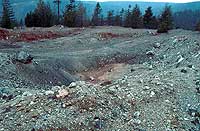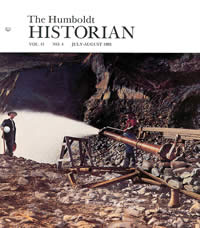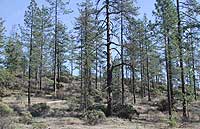USDA Forest Service Celebrating Wildflowers
|
|
|
Conserving the Botanical Richness of Serpentine Communities
“Barren, infertile, rocky, exposed, and toxic.” With the exception of early botanists roaming the hills of the Klamath-Siskiyous, many who laid their eyes on serpentine landscapes shared this harsh perspective. In the mid-1800s, the only value of these areas was the money to be made in exploiting the minerals and heavy metals that characterize serpentine rock. Practices in those days involved pick and shovel mining, digging deep tunnels, hydraulic mining, and around the turn of the century, explosives. Trees were cleared to provide wood for cabins that housed the miners and their families. Timbers were also used to align the openings of shafts and tunnels, and for construction of mining-related structures. Over the decades, trees, shrubs, and herbs that slowly made their way onto the disturbed areas now scantly cover some of the scars of historic mining. During the 1970s of the 20th century, exploratory mining in the coastal Klamath-Siskiyou serpentines left in its wake a grid of mining roads, pits, and piles of mine tailings. As a result, serpentine plant communities became fragmented and isolated. This led to changes in pollinator behavior and thus gene flow. Water dependent communities, such as the Darlingtonia wetlands, were deprived of water as poorly designed mining roads intercepted and displaced water elsewhere. Habitat for rare serpentine endemics became even more rare and threatened with extirpation or extinction. Other challenges to the conservation of serpentine communities are related to illegal cross-country travel, spread of Port-Orford-cedar root disease, and the slow creep of invasive species along roadways leading to serpentine areas. National Forest botanists and other resource specialists have initiated restoration projects to heal past disturbance through the planting of locally collected native plant species. Areas of our National Forests have been designated Botanical Special Interest Areas and Research Natural Areas to conserve the uniqueness and many values of serpentine communities. The North Coast Chapter of the California Native Plant Society maintains plant list for two Botanical Special Interest Areas featuring serpentine communities on the Six Rivers National Forest. Importantly, the public is becoming aware of the extraordinary beauty of these areas and the extraordinary circumstances under which serpentine plant communities exist. Serpentine Plant Community Viewing AreasCalifornia
Oregon
BookmarksBotanical Special Interest Areas - The US Forest Service has established a series of Special Interest Areas (SIAs) to conserve unique areas of the National Forests. Botanical SIAs have been specifically designated to conserve and manage unique botanical communities, rare species, or other elements of biological diversity, and to provide for public enjoyment of these areas in a manner that is consistent with the values for which the area was established. Research Natural Areas - Research Natural Areas (RNAs) are a part of a national network of ecological areas designated in perpetuity for non-manipulative research and education, and to maintain biological diversity on National Forest System Lands. |
|
| NOTE: PDF format links require the Adobe Acrobat Reader to view. | |
| top | Disclaimers | FOIA | Privacy Policy | Quality of Information | Photo Credits & Use |
Location: http://www.fs.fed.us/wildflowers/communities/serpentines/conservation/index.shtml
Last modified: Wednesday, 03-Dec-2008 13:54:34 EST


